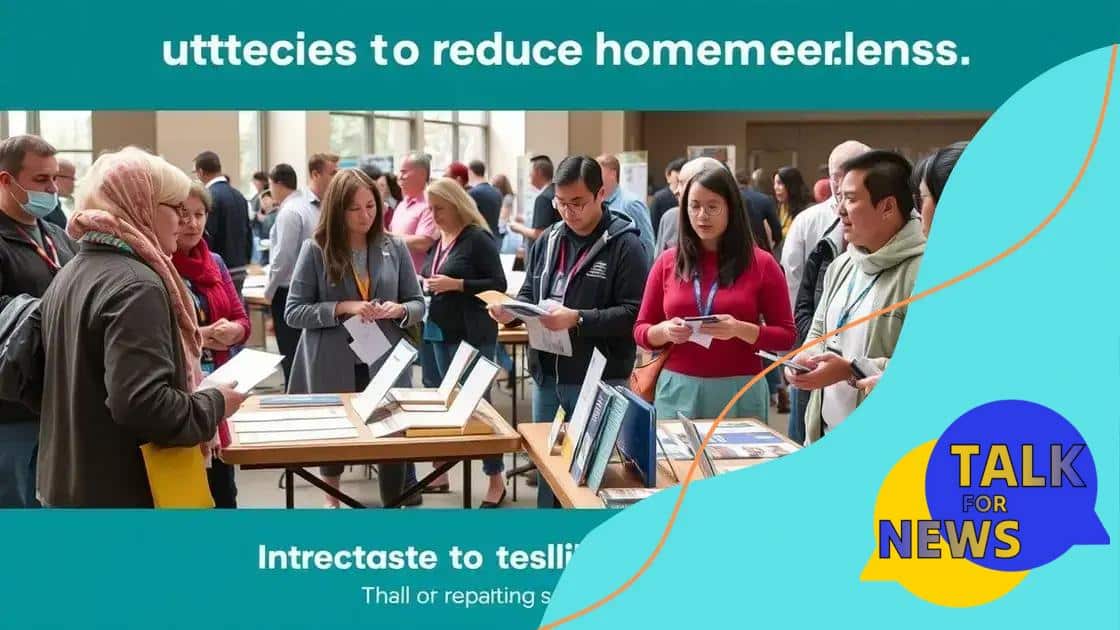How federal government is addressing housing insecurity

Anúncios
The federal government is addressing housing insecurity through various initiatives, including funding programs, innovative housing solutions, and community partnerships aimed at providing affordable and stable housing for those in need.
How federal government is addressing housing insecurity is more than just a policy issue; it affects millions. Have you ever wondered how these strategies impact local communities? Let’s explore the measures in place to support those in need.
Anúncios
Current policies combatting housing insecurity
Current policies aimed at combating housing insecurity are crucial in today’s society. These initiatives play a significant role in shaping the living conditions for many individuals and families. Understanding these policies can help communities advocate for necessary changes and support.
Key Policies in Place
Various federal and state policies are designed to address housing insecurity. They focus on providing assistance to those in need, ensuring access to affordable housing, and promoting stability within communities.
- Housing Choice Voucher Program: This allows low-income families to afford housing in the private market, giving them more options.
- Low-Income Home Energy Assistance Program (LIHEAP): Offers financial assistance for energy costs, helping families keep their homes safe and heated.
- Continuum of Care Program: Coordinates housing and services for homeless individuals and families, focusing on long-term stability.
- Community Development Block Grants (CDBG): Provide funding to support community development projects, enhancing housing opportunities.
Anúncios
Additionally, changes in laws and regulations can directly impact housing policies. These shifts often aim to make housing more accessible. For example, removing zoning restrictions can lead to increased housing availability in many areas.
Another aspect to consider is how local governments adapt federal policies to meet unique community needs. Some regions may implement their own strategies that align with federal guidelines while addressing specific local challenges.
Overall, the landscape of housing security is continually evolving. By keeping abreast of these changes, communities can better respond to the needs of their residents and advocate for effective solutions.
Federal funding programs for housing assistance
Federal funding programs for housing assistance are crucial resources for families facing economic challenges. These programs aim to help individuals secure stable housing while providing a safety net during difficult times.
Types of Federal Funding Programs
Several key programs assist low-income families and individuals, making housing more accessible. Each of these programs has specific eligibility criteria and benefits that can be incredibly impactful.
- Section 8 Housing Choice Voucher Program: This program allows families to choose their housing while receiving rental assistance, significantly lowering their monthly costs.
- Public Housing: Managed by local housing authorities, this program provides affordable rental options in designated public housing units.
- Home Investment Partnerships Program (HOME): This program offers grants to states and localities to create affordable housing, focusing on low-income households.
- Emergency Solutions Grants (ESG): These grants provide funds for homeless prevention and shelter programs, aimed at assisting families and individuals in crisis.
Understanding these programs can empower community members to seek help and advocacy. Many of the federal funding initiatives aim to reduce homelessness and support housing stability. Communities can leverage these programs to improve living conditions.
Some programs are designed specifically for veterans, seniors, and individuals with disabilities. These targeted initiatives ensure that vulnerable populations receive the assistance they need to find stable housing and improve their quality of life.
Local organizations often work closely with federal agencies to maximize the impact of these funds. By collaborating, they can create localized solutions to address housing challenges effectively. As these programs evolve, their adaptability proves essential in meeting the changing needs of communities.
Community partnerships to reduce homelessness

Community partnerships play a vital role in reducing homelessness by bringing together various organizations, local governments, and community members. This cooperation is essential to create effective strategies for assisting those in need.
Benefits of Partnerships
When communities work together, they can pool resources and maximize their impact. Here are some key benefits of these collaborations:
- Shared Resources: Partnering allows organizations to share financial and material resources, which can lead to more effective programs.
- Diverse Expertise: Different organizations bring unique skills and knowledge, enhancing the quality of services provided to the homeless.
- Greater Awareness: Community partnerships can help raise awareness about homelessness, encouraging more people to get involved and support the cause.
- Holistic Solutions: Collaborative efforts can develop comprehensive approaches to address not only housing issues but also mental health and employment needs.
Implementing community-based strategies requires a shared commitment. Local organizations often engage with residents to understand their specific needs and tailor solutions accordingly. By fostering open communication, these partnerships can adapt to changing circumstances and refine their approaches over time.
Successful programs often include collaborations with local businesses, faith-based organizations, and schools. These partners can provide invaluable support through funding, volunteer efforts, or practical resources for homeless individuals. Working together helps break down silos, allowing for a more unified response to the issue of homelessness.
Events such as community forums or resource fairs also play a significant role in building these partnerships. They create opportunities for outreach and engagement, encouraging more stakeholders to join the fight against homelessness and support those in need.
Innovative solutions for affordable housing
Innovative solutions for affordable housing are essential in addressing the growing housing crisis. As more individuals and families struggle to find affordable homes, new approaches are emerging to facilitate access and affordability.
Creative Housing Models
One of the most promising trends is the development of alternative housing models. These approaches can include:
- Co-housing: This model allows individuals to share living spaces while maintaining privacy. Residents collaborate on community activities, reducing costs.
- Micro-housing: Small, efficiently designed homes that provide affordable options for singles and small families. They often occupy less land and require fewer resources.
- Shipping Container Homes: Repurposing shipping containers into livable spaces can be a cost-effective solution. They are durable and can be modified to suit various needs.
- Accessory Dwelling Units (ADUs): These secondary housing units are built on existing properties. They provide additional rental income and increase housing options in dense neighborhoods.
In addition to these models, technology has a growing role in creating affordable housing. Using advanced building techniques, such as 3D printing, can reduce construction costs and time. This innovation has the potential to offer affordable options quickly while adjusting to local needs.
Partnerships with nonprofit organizations and government agencies can also lead to innovative solutions. By working together, they can secure funding and resources for affordable housing projects. These collaborations often lead to unique initiatives that directly benefit low-income families.
Furthermore, sustainable building practices are proving to be an effective way to create affordable housing. By focusing on energy efficiency and reducing waste, developers can lower overall costs, making housing more affordable in the long run.
Challenges faced in addressing housing need
Addressing the growing housing need presents several challenges that communities must navigate. These obstacles can hinder efforts to provide affordable and stable housing for all.
Key Challenges
Many factors contribute to the complexity of the housing crisis, including economic, social, and political issues. Here are some of the main challenges:
- Rising Housing Costs: As property values and rents continue to increase, many families find it difficult to afford adequate housing.
- Limited Funding: Many housing initiatives rely on federal and state funding, which can be limited or inconsistent, hindering their overall effectiveness.
- Zoning Regulations: Strict zoning laws can restrict the development of affordable housing options and limit the availability of land for new builds.
- Homelessness Stigma: People experiencing homelessness often face stigma, making it difficult for them to access resources and support.
These factors create a challenging environment for organizations tasked with alleviating housing insecurity. Moreover, economic downturns can further exacerbate these issues, leading to increased homelessness and a greater demand for affordable housing.
Another critical challenge is the lack of awareness about available resources. Many individuals who are experiencing housing instability may not know what programs exist to help them. This disconnect can prevent those in need from accessing vital services and support.
Additionally, the COVID-19 pandemic has highlighted vulnerabilities in the housing system. Job losses and health crises significantly impacted many households, amplifying the existing housing need. As communities recover, addressing these issues requires innovative thinking and coordinated efforts.
In conclusion, addressing housing insecurity is a multifaceted endeavor requiring collective action and innovative solutions. While challenges such as rising costs, limited funding, and stigma persist, community partnerships and federal support can pave the way for effective change. By understanding the needs and mobilizing resources, we can work together to create a future where everyone has access to safe and affordable housing.
FAQ – Frequently Asked Questions about Housing Insecurity
What are the main challenges in addressing housing insecurity?
Key challenges include rising housing costs, limited funding for housing programs, strict zoning regulations, and the stigma surrounding homelessness.
How can community partnerships help in reducing homelessness?
Community partnerships can pool resources, enhance outreach, and provide diverse expertise to create effective solutions for those facing housing instability.
What innovative solutions are being used for affordable housing?
Innovative solutions include co-housing, micro-housing, shipping container homes, and accessory dwelling units, which can provide affordable living options.
Why is awareness about housing resources important?
Raising awareness ensures that individuals in need understand what assistance is available, increasing their chances of finding support and stable housing.





